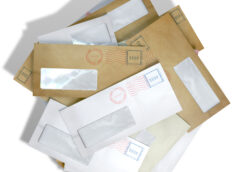In an order issued September 27, the Postal Regulatory Commission approved as filed the “growth incentives” proposed by the Postal Service on August 11.
The incentives
As the USPS stated in its filing:
“… The two incentives are substantially identical. A mailer is eligible for the First-Class Mail Growth Incentive when its combined volume of qualifying pieces in the incentive period, calendar year 2024, exceed the incentive threshold. Qualifying pieces are pieces mailed as First-Class Mail Presort Letters, First-Class Mail Presort Cards, or First-Class Mail Presort Flats.
“Similarly, a mailer is eligible for the Marketing Mail Growth Incentive when its combined volume of qualifying pieces in calendar year 2024 exceed the incentive threshold. Qualifying pieces are pieces mailed as Marketing Mail Letters and High Density/Saturation Letters, Marketing Mail Flats and High Density/Saturation Flats & Parcels, Marketing Mail Carrier Route, or Marketing Mail Parcels.
“Under both incentives, for every qualifying piece mailed in calendar year 2024 after the first million pieces, mailers receive a credit equal to 30 percent of the average per-piece price paid for mailing all qualifying pieces, unless the volume of qualifying pieces the mailer sent in the preceding fiscal year exceeded 1,000,000 pieces. In that case, credits accrue only after the mailer surpasses its fiscal year 2023 volume of qualifying pieces.
“For example, for either incentive, if a mailer sent 900,000 qualifying pieces in fiscal year 2023, the mailer earns credits for pieces mailed in calendar year 2024 beginning with piece 1,000,001. But if a mailer sent 2 million qualifying pieces in fiscal 2023, then this mailer earns credits for pieces mailed in calendar year 2024 beginning with piece 2,000,001.
“The use of calendar year 2024 for the incentive period and fiscal year 2023 for the comparison period is intentional. Doing so allows the Postal Service time to complete the administrative setup of the incentives before the incentive period begins.
“Calculating the credits earned is somewhat complex. There is more than one qualifying product for each incentive, and within any given product, pieces of different weights, sortation levels, and dropship locations have different prices.
“Accordingly, for each incentive, the credits earned are equal to the average actual per-piece price paid for all qualifying volume, after other incentives and promotions, i.e., the total actual price paid for all qualifying pieces (not including any special services that might be added to and paid for with these pieces), divided by the total volume of qualifying pieces. This average is then applied to the total volume of pieces eligible for credits.
“For example, assume a mailer sends 5 million qualifying pieces in calendar year 2024 and sent 4.5 million qualifying pieces in fiscal year 2023. Table 1 shows how those 5 million pieces were distributed across three products and the prices the hypothetical mailer paid. The example uses generic product names because it illustrates both incentives.

“Given that the mailer paid $3,194,000 for 5 million qualifying pieces, the average per-piece price is $3,194,000 / 5,000,000 = $0.639.
“The mailer’s fiscal year 2023 qualifying volume was 4.5 million pieces, so it earns credits only on the last 500,000 pieces of the 5 million it mailed.
“Thirty percent of the average, per-piece price paid of $0.639 for 500,000 qualifying pieces equals a credit of: 500,000 * 0.639 * 0.30 = $95,850.
“Distributed across the total mailing of 5 million pieces that generated $3.2 million, the actual, per-piece credit is a much lower 3%.
“Credits will be issued in July and October 2024 and in January or February 2025. Once issued, a mailer may use credits any time before the end of calendar year 2025.
“Finally, credits from the First-Class Mail Growth Incentive can only be used for future mailings of qualifying First-Class Mail pieces. Credits from the Marketing Mail Growth Incentive can only be used for future mailings of qualifying Marketing Mail pieces.”
In its August filing, the USPS estimated that “approximately 17% of Marketing Mail volume will earn credits during the incentive period,” generating between $804 million and $1.34 billion in additional revenue, and returning between $241 million and $421 million in credits to eligible participating mailers. The agency would also generate unused rate authority because of the incentives, but would not have sufficient data to finalize or use that authority until 2025.
Lowering rates
Examining a filing in which the USPS asked to lower prices was untrodden territory for the commission.
Looking at the variety of statutory and regulatory requirements involved, the PRC found no issues with the incentive for First-Class Mail, but the Marketing Mail incentive drew attention because the class includes three categories (Marketing Mail Flats, Carrier Route, and Parcels) that are non-compensatory (i.e., their rates are “underwater”). In the end, the commission said the applicable rule were “ambiguous” regarding filings to lower prices, but concluded that
“The total package of incentives proposed in this proceeding appears to be envisioned to mutually benefit the Postal Service and mailers as the incentives seek to encourage new and increased volume, improve the Postal Service’s financial position, and provide benefits to mailers. … Thus, the Commission concludes that it is neither appropriate nor productive to read [its regulations] in a way that would prevent the Postal Service from innovating through the creation of incentives and that would otherwise disincentivize or prohibit such incentives. The Commission’s intent behind these regulations was not to preclude the Postal Service from using its pricing flexibility in innovative ways, and thus the Commission concludes that [the relevant regulations] are most appropriately interpreted to apply in rate adjustment proceedings where rates are not solely proposed to decrease through the offering of incentives.”
In its order, the PRC mandated data reporting requirements by May 15 and by sixty days after both the close of each quarter and the end of the incentive period. The effective date for the incentives, as requested by the Postal Service, is January 1, 2024.


